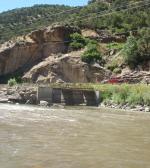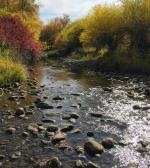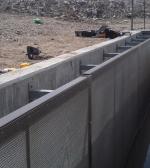Reconnect

We Make Fishing Better
An angler fishing a favorite stretch of stream might not think of it as being part of a larger watershed or basin. But that broader, landscape-scale vision is key to Trout Unlimited’s conservation strategy and success. Simply put, a river is greater than the sum of its parts. A river ecosystem is healthiest when it is integrated and whole, with mainstem and tributaries connected, offering diverse habitat that serves a range of fish needs, from shelter to food.
In many places, however, rivers and streams have become fragmented by barriers and low flows, which block trout from reaching stretches that might provide better shelter, food or spawning opportunities. Those in-stream obstacles and bottlenecks can hinder trout populations throughout the watershed and prevent them from thriving.
That’s why reconnecting streams and improving fish passage is such an important part of TU’s conservation work. It also provides real bang for the conservation buck: A single removed barrier can deliver impressive benefits, improving fish passage for miles upstream and downstream.
And when a river is healthy and connected, it’s more likely that anglers will connect with fish.
Over the years, human activities, from agriculture to development, have created barriers in many river systems. The obstacles include diversion dams—ranging from aging concrete structures to “push-up” dams constructed each year from stream cobble and debris—that block fish passage and destroy in-stream habitat. Often the fix involves removing or modifying a structure—for instance, installing a fish ladder on a diversion that allows fish to access upstream habitat.
Low flows—caused by irrigation diversions and drought—can also dewater a stretch to the point that it creates a barrier to fish passage. In that case, TU works with partners to find solutions, such as upgraded infrastructure and innovative water management, to ensure that enough water remains in-stream to keep trout populations alive and connected.
TU invests in reconnect projects that offer the biggest returns, in terms of opening up number of miles of habitat and improving high-value trout populations. For example, near Jackson, Wyoming, TU recently worked with local partners to remove an aging dam on Spread Creek, a key tributary of the Snake River and an important spawning and rearing area for Snake River cutthroat trout. By removing the obsolete dam, which was no longer needed for irrigation, TU was able to open up more than 50 miles of the upper reaches of Spread Creek for fish spawning and rearing.
Nearby, TU followed up by removing a similar aging diversion structure on the Gros Ventre, another important Snake tributary, opening up some 100 miles of habitat. These reconnect projects are part of a larger strategy to strengthen the Snake system and help guarantee that fishing this legendary river remains awe-inspiring, far into the future.




